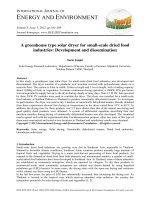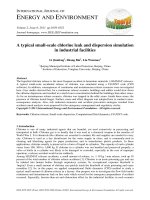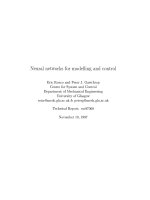Small scale stand for testing different control algorithms on assisted brake systems
Bạn đang xem bản rút gọn của tài liệu. Xem và tải ngay bản đầy đủ của tài liệu tại đây (390.49 KB, 5 trang )
12th IFToMM World Congress, Besançon (France), June18-21, 2007
Small scale stand for testing different control algorithms on assisted brake systems
V. Ciupe*
I. Maniu†
“Politehnica” University “Politehnica” University
Timisoara, Romania
Timisoara, Romania
Abstract — The paper presents a scaled testing stand for
applying different algorithms onto an assisted brake system in
order to determine the best way to control the braking process.
Keywords: test stand, braking, ABS, control, tire-slip.
I. Introduction
The Antilock Braking System (ABS) is an important
component of a complex braking-steering system for the
modern car. It is now available on most of the vehicles,
enhancing their braking capabilities. The early systems
were mechanical systems and performed with varying
degrees of efficiency, but they significantly improved
vehicle steerability during braking. This ability of the
early systems encouraged further development.
Today, ABS systems can be found on most of the
vehicles, tending to be standard equipment. The main
objective of most of these control system is prevention of
wheel lock while braking. This is important for two main
reasons. First to maintain steering ability of the car while
hard emergency braking and in order to enable obstacle
avoidance in such situations. Second, for decreasing the
braking distance in case of an emergency braking. The
later is due to the fact that the maximum friction between
the road and the tires is, in most of the cases, achieved
when the wheel is still rotating and not when is locked.
It turns out that this task is not trivial, one of the main
reasons being the high amount of uncertainty involved.
Most uncertainty arises from the friction between the
tires and the road surface. In addition, the tire-road
characteristic is highly nonlinear, which burdens even
further the control task.
In order to design an efficient ABS one needs to know
the dependencies between the applied brake torque and
friction between tires and road surface.
II. The tire-road model
The model that describes forces involved during braking
is derived from the well known quarter car model. This
consists of a single wheel attached to a mass, as shown in
figure 1.
*E-mail:
† E-mail:
Fig. 1. Quarter car model
Fig. 2. Longitudinal tire slip for different road surfaces.
A simplified model of wheel dynamics subject to brake
torque and ground forces is described by the following
relations:
dω (t )
= α ⋅ µ (λ (t )) − β ⋅ Tb (t − τ ) ⋅ µ b (ω (t )). Tb ≥ 0 (1)
dt
dv (t )
= −γ ⋅ µ (λ (t ))
dt
(2)
v(t ) − ω (t ) ⋅ r
.
v(t )
(3)
λ (t ) =
where:
ω - angular velocity of the wheel;
v - velocity over ground of the car;
12th IFToMM World Congress, Besançon (France), June18-21, 2007
λ - longitudinal tire slip;
Tb - brake torque. It is the input signal of the model;
µ - road-tire friction coefficient;
µb - friction coefficient in the brakes;
τ - time delay;
r - wheel radius
α, β, γ - positive constants, resulting from physical
parameters of the vehicle.
The constants given in the model have the following
physical interpretation:
α=
r ⋅ Fz
F
1
, β= , γ = z.
J
J
m
(4)
where:
m – mass of the quarter car;
Fz – vertical (normal) force;
r – wheel radius;
J – wheel inertia.
The longitudinal tire slip (λ) definition will imply that a
locked wheel ( ω=0) is described by λ=1, while the free
motion of the wheel ( ωr= v) is described by λ=0.
The tire friction force, is determined by
Fz.µ(λ, µH, α, Fz, v) where µ(λ, µH, α, Fz) is the road-tire
friction coefficient. This is a nonlinear function with a
typical dependence on the slip shown in (figure 1), based
on Pacejka’s “magic formula”. This model uses static
maps to describe dependence between slip and friction
and it can depend on the vehicle’s velocity (v). This
function depends also on the normal force (Fz), steering
angle (α) and road surface (having different maximum
values µH for different road conditions). For ease of
writing, the model equations highlight only the
dependence on the longitudinal tire slip (λ).
In figure 2 there are shown tire friction curves,
generated by the Pacejka model, for four different kinds of
surfaces.
Notice that this model contains a quite simple
description of the slip dynamics for a wheel. It does not
capture pitching motion of the car body while braking,
suspension dynamics, actuator dynamics, tire dynamics
nor camber angle (in the above given model, the tire is
consider perpendicular on the road surface). However, it
captures the major control challenges of the problem.
III. Existent ABS operation algorithm
By looking at the curves, it is obvious that an efficient
anti lock system must maintain a slip percentage of the
tire at about 10-20%. And that is what today’s ABS’ are
trying to do.
The preferred method is the use of decoupling solenoid
valves and a piston electro-pump. The functional principle
is as follows: the ABS controller (ECU) monitors wheel
speeds via reluctance speed sensors. If (while braking)
one wheel spins slower (decelerates faster) then a software
interrupt is triggered, raising a “lock tendency” event,
which launches a special routine. This routine looks-up in
a data table and figures out that the pressure in the caliper
must be reduced. A tri-state solenoid valve is actuated on
its first stage, in order to release the excess pressure. The
routine looks up in the table again and after the requested
time elapsed it knows that must enter maintaining phase.
The solenoid valve is now commuted to its second stage,
the caliper is isolated from the rest of the brake circuit
and, having a low pressure allows for the wheel to spin
up. The routine looks one more time in the data table and
after maintaining time elapsed commutes the valve in the
third state and with help from the electro-pump builds up
pressure to that caliper. The pressure rises again until the
lock tendency reappears and the whole process repeats
until full stop (actually car speed less than 10 km/h) or
foot off the brake pedal.
The method described above ensures a good steerability
and a very small percent of slip during braking. But those
ABS’ (which are the only ones used in today’s series
passenger cars) have their disadvantages: the sudden
changes in pressure give undesired vibrations in the brake
pedal and chassis, big offset from the desired slip and in
many cases it has been demonstrated to significantly
increase stopping distance (panic brake cases).
IV. The scaled test stand
The test stand for the antilock brake systems must
simulate real running conditions of a car over a certain
surface (asphalt, concrete, muddy, icy or wet roads) by
taking into account the dynamics of the that system and
particularly the down force of the wheel (car’s mass),
kinetic energy during braking (inertia) and adherence
coefficient (nature and aspect of the road).
In order for the measurements to be precise every
parameter must be modified according to test’s needs. It
must be stated that is sufficient to test only one wheel (out
of the four) in order to determine the functional
parameters of the equipment.
Also it is preferred to have a scaled test stand for space
reasons and the ease of modifying.
Due to the fact that in laboratory conditions cannot be
realized a suitable longitudinal test track, it must be
shaped as a cylindrical tambour having its width at least
equal to that of the tested wheel. This tambour should
have its surface grade close to that of asphalt or concrete
and its peripheral velocity should be similar (scaled) to a
vehicle traveling at a safe speed (50-100 km/h). Also the
inertia of the tambour should be scale-equivalent to that of
a quarter of the simulated vehicle.
Considering solved the problem of the track (tambour)
the following must be taken into account: the down force
exerted by the wheel must be a quarter of the scaledweight of the vehicle and the link between wheel and
12th IFToMM World Congress, Besançon (France), June18-21, 2007
tambour (track) must emulate the elastic component of the
suspension. Such a solution is represented in figure 3.
test
N
Tω
ω
F
Tω
ω
M.
G
track
Fig. 3. The scaled testing stand principle.
The actual testing stand (figure 4) comprises a support
table (1), having the role to sustain the other components,
the track tambour (2) having the required inertial mass
and being driven by the electric motor (3), the test wheel
(4) having texture and form similar to a real-sized car
wheel. The wheel is mounted with the fixtures (5) which
are fixed on the support plate (7). The caliper (6) is
mounted on its support in such a way that allows for
movement along the axis of the wheel (floating caliper).
Fig. 5. 3D model of the stand (test wheel assembly).
From a functional point of view (figure 5) the stand
works as follows: the electric motor drives the tambour
which is in contact with the rolling surface of the test
wheel (9). On the wheel hub is mounted the brake disc (2)
locked to the wheel with 6 bolts (1). This assembly is
supported by two ball bearings at each end (4). Two brake
pads press against the brake disc with the help of an
electromagnetic caliper. This comprises the floating frame
supporting the coil and guiding the ferromagnetic core
which in turn presses against the brake pads. The beam
(10) is there for reinforcing the assembly and at the same
time supports different masses used to produce the normal
down force onto the test wheel. The optoelectronic
transducer (11) feeds back to the computer pulses that
translate into angular velocity of the test wheel. There is
another identical transducer mounted onto the motor’s
shaft used to reference the tambour’s angular velocity.
Fig. 4. 3D model of the stand (general view).
Fig. 6. Electronic schematics of the test stand.
12th IFToMM World Congress, Besançon (France), June18-21, 2007
V. The software component
In order to control de scale test stand a program has
been conceived in Visual Basic and the access to the
parallel port was achieved using a special driver, “io.dll”.
Data processed by the program are saved in a file for later
analysis. In figure 7 is presented a screen capture of the
program. It can be noticed that it has the possibility to
change different parameters for the abs operation and also
to apply different control algorithms like panic brake with
no abs, normal abs and adaptive abs. Adaptive ABS is a
newly proposed method that should keep the relative slip
of the wheel around 20% by controlling continuously the
braking torque.
where: vR – test wheel speed; vC – run track speed; RR –
test speed radius; RC – run track (tambour) radius; NIR –
number of pulses given by the wheel in the time tp; NIC –
number of pulses given by the tambour in the time tp; N –
number of pulses per revolution.
VI. Test results
Using the above-presented test stand, different
algorithms were tested in order to determine the most
efficient one.
In figure 8 the results of a braking with wheel lock-up is
represented. The blue line is the trend-line of the
tambour’s velocity and the red line is the trend-line of the
tested wheel. It can be noticed that the wheel locks almost
instantaneously (0.2s) and the whole system comes to a
stop (from approximately 5.4 m/s) in 2.02 seconds.
6
5
4
Viteza [mm/s]x100
From the control point of view, the stand is linked to the
parallel port of a regular PC. By following the schematics
in figure 6, one can observe that bit D0 of port 378 opens
a bipolar transistor which in turn allows current through
the motor’s relay. Bit D1 opens a MOS-FET transistor
which commands the caliper’s electromagnet. Bits D2 and
D3 are used to feed current to the transducers’ IR emitting
diodes. Values given by the IR transistors are read in the
status port 379, respectively pins S4 and S5.
3
2
1
0
0
0.5
1
1.5
2
2.5
3
3.5
-1
Timp [s]
Fig. 8. Braking with wheel lock-up.
In the above image the blue line represents the trend of
the peripheral speed of the track (tambour) and the red
line is the trend of the test wheel’s peripheral velocity.
Determination of the two peripheral velocities is done by
taking into account that: the run radius of the tambour at
contact point is 66mm; the run radius of the test wheel at
contact point is 65mm; there are 90 pulses per revolution
at both encoders. The peripheral speeds resulting from
above parameters are given by relation (5):
vR =
2 ⋅ π ⋅ RR ⋅ N IR
[ mm / s]
N ⋅tp
2 ⋅ π ⋅ RC ⋅ N IC
vC =
[mm / s ]
N ⋅tp
6
5
4
Viteza [mm/s]x100
Fig. 7. GUI for the ABS test stand.
In figure 9 braking with normal ABS is executed. The
braking time (distance) increases close to 2.24 seconds
when using ABS on a dry surface (obvious if one looks at
the graph and notices lock-unlock cycles), but the gain is
in steering control due to the fact that the mediated wheel
speed (red line) approaches a more desirable slip value.
3
2
1
(5)
0
0
0.5
1
1.5
2
2.5
-1
Timp [s]
Fig. 9. Braking with normal ABS.
3
3.5
12th IFToMM World Congress, Besançon (France), June18-21, 2007
6
The use of a scaled test stand allows for numerous
experimental tests with less costs and time. It also permits
the easy modification of every desired parameter, the
results being ready for interpretation in a very short
amount of time. The results are fairly accurate when
scaled back to real size system and the testing on a real
size vehicle are more predictable; fine tuning the real
system being effortless and time efficient.
5
References
And in figure 10 a test result on braking with adaptive
ABS is shown. It can be easily noticed that the mediated
wheel velocity stays closer to the desired 20% of relative
slippage, compared to normal ABS braking. Also the
braking time was seriously reduced to 2.06 seconds.
Viteza [mm/s]x100
4
3
2
1
0
0
0.5
1
1.5
2
2.5
3
3.5
-1
Timp [s]
Fig. 10. Braking with adaptive ABS
It must be stated that all three test were conducted with
the same stand setup in order to have as less parameter
variation as possible.
VII. Future work
The stand described in this paper offers a high flexibility
in implementing different control algorithms and
parameter modification. This is first due to its reduced
size but mostly to the electromagnetic actuated caliper.
The future for an assisted brake test stand is to build a
more versatile and closer to today’s automotive braking
systems scaled test stand. This will be achieved by
constructing a remotely controlled, scaled vehicle (1:4.6
overall scale) having rear wheel drive, full independent
suspension and front Ackerman steering wheels. It is
designed to have discs and hydraulic calipers all around.
Master cylinder will be split in four, independently
controllable linear electro-hydraulic actuators.
This approach will give far better results under different
braking conditions and will allow for numerous
algorithms and variations to be tested.
VIII. Conclusion
Making vehicles and roads safer is a top priority for
every design engineer in automotive industry or research
group.
Different methods have been proposed over the years for
shortening stopping distances and maintaining a good
steerability while braking. Of all, the current ABS
approach seems to be the design of choice due to
demonstrated reliability, developing-related, production
and integration costs.
[1] Ciupe V., Gligor O. A different approach in the control methods for
automotive antilock brake systems. In The 2nd International
conference on robotics, Timisoara & Resita, October 2004.
[2] Solyom S. Synthesis of a Model-based Tire Slip Controller.
Licentiate thesis, Department of Automatic Control. Lund Institute
of Technology, 2002.
[3] Ulsoy A. G. and Peng H. Vehicle Control Systems, Lecture notes,
1997.
[4] Solyom S., Rantzer A. and Kalkkuhl J. A Benchmark for Control of
Antilock Braking Systems, Department of Automatic control. Lund
Institute of Technology, 2001.
[5] Canuda-de-Wit C. and others. Dynamic Friction Models for
Road/Tire Interaction. Vehicle System Dinamics, Draft Article.
Laboratoire d'Automatique de Grenoble, 2002.









